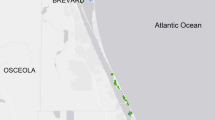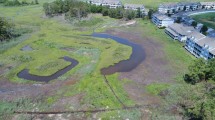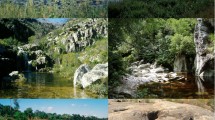Abstract
Salt marshes of the Indian River Lagoon, Florida (USA) were once prolific producers of mosquitoes. Mosquitoes lay their eggs on the infrequently-flooded high marsh surface when the soil surface is exposed. The eggs hatch when the high marsh is flooded by the infrequent high tides or summer rains. To control mosquito production, most of the salt marshes (over 16.200 ha) were impounded by the early 1970s. Flooding, usually by pumping water from the Lagoon, effectively controlled mosquitoes.
However, impounding had a profoundly negative impact on the wetland plant, fish, and invertebrate communities. Isolation from the Lagoon cut off aquatic access by transient estuarine species that used the wetlands for feeding or as nursery area. In one study, the number of fish species dropped from 16 to 5 after impounding. Wetland vegetation within some impoundments was totally eliminated; other impoundments developed into freshwater systems.
When tidal exchange is restored through hydrologic connection, usually by culverts installed through the perimeter dike, recovery to more natural conditions is often rapid. In one impoundment where wetland vegetation was totally eliminated, recovery of salt-tolerant plants began almost immediately. In another, cover of salt-tolerant plants increased 1,056% in less than 3 years. Fisheries species that benefitted the most were snook, ladyfish, and striped mullet. Over 1,500 juvenile snook were captured in a single 3-hr flood-tide culvert trap as they attempted to migrate into an impoundment. The zooplankton community rapidly returned to the more typical marsh-Lagoon community. Water quality and sediment sulfides returned to typical marsh values. Overall, reconnection enhances natural productivity and diversity, although water quality in the perimeter ditch, an artifact of dike construction, remains problematic.
Earlier experiments demonstrated that flooding only during the summer mosquito breeding season provided as effective mosquito control as year-round flooding. In standard management, the impoundment is flooded in summer, then left open to the Lagoon through culverts the rest of the year. Culverts are typically opened when the fall sea level rise first floods the high marsh.
Impoundment reconnection is being implemented by a multi-agency partnership. The total reconnected area is expected to reach 9,454 ha by the end of 1998, representing 60% of the impounded wetlands in the entire IRL system. One stumbling block is private ownership of many of the remaining isolated impoundments.
Similar content being viewed by others
Literature Cited
Almasi, M.N. 1983. Holocene sediments and evolution of the Indian River (Atlantic coast of Florida). Ph.D. dissertation. Univ. of Miami, Coral Gables, Fl. 238 pp.
Antlfinger, A.E., and Dunn, E.L. 1979. Seasonal patterns of CO2 and water vapor exchange in three salt marsh succulents. Oceanologia, 43: 249–260.
Bell, F.W. 1989. Application of wetland valuation theory to Florida fisheries. Florida Sea Grant SGR-95. Gainesville. Fla. 131 pp.
Carlson, D.B. and Carroll, J.D., Jr., 1985. Developing and implementing impoundment management methods benefiting mosquito control, fish and wildlife: a two year progress report about the Technical Subcommittee on Mosquito Impoundments. J. Fl. Anti-Mosquito Assoc., 56: 24–32.
Carlson, D.B., O'Bryan, P.D. and Rey, J.R. 1991. A review of current salt marsh management issues in Florida. J. Amer. Mosquito Control Assoc., 7: 83–88.
Carlson, P.R. and Forrest, J. 1982. Uptake of dissolved sulfide bySpartina alterniflora: Evidence from natural sulfur isotope abundance ratios. Science, 216: 633–635.
Carlson, P.R., Yabro, L.A., Zimmermann, C. and Montgomery, J.R. 1983. Pore water chemistry of an overwash mangrove island. Fl. Sci., 46: 239–249.
Childers, D.L., and Day, J.W. 1990. Marsh-water column interactions in two Louisiana estuaries II. Nutrient dynamics. Estuaries, 13: 404–417.
Clapp, D. 1987. Chapter 1. Overview of physiographic and surface drainage features.In: Steward, J.S. and VanArman, J.A. (eds). Indian River Lagoon Joint Reconnaissance Report. pp. 1.1–1.27. St. Johns River and South Florida Water Management Districts. Palatka and West Palm Beach, Florida.
Clements, B.W. and Rogers, A.J. 1964. Studies of impounding for control of salt-marsh mosquitoes in Florida, 1958–1963. Mosquito News, 24: 265–276.
Craft, C.B., Broome, S.W., and Seneca, E.D. 1989. Exchange of nitrogen, phosphorous and organic carbon between transplanted marshes and estuarine waters. J. Environ. Quality. 18: 206–211.
Day, J.W., Hall, C.A.S., Kemp, W.M., and Yanez-Arancibia, A. 1989. Estuarine Ecology. John Wiley & Sons, New York.
Ellison, A.M. and Farnsworth, E.J. 1993. Seedling survivorship, growth, and response to disturbance of Belizean mangroves. Amer. J. Botany, 80: 1137–1145.
Fernald, E.A. and Purdum, E.D. 1992. Atlas of Florida. Univ. Fla. Press. 280 pp.
Gardner, L.R., Wolaver, T.G., and Mitchell, M. 1988. Spatial variation in the sulfur chemistry of salt marsh sediments of North Inlet. South Carolina. J. Mar. Res., 46: 815–836.
Gilmore, R.G., Jr. 1987. Fish. macrocrustacean and avian population dynamics and cohabitation in tidally influenced impounded subtropical wetlands.In: Whitman, W.R. and Meredith, W.H. (eds). Symposium on Waterfowl and Wetlands Management in the Coastal Zone of the Atlantic Flyway. pp. 373–394. Del. Coast. Manag. Program. Del. Dept. Nat. Res. and Envir. Control, Dover, Del.
Gilmore, R.G., Cooke, D.W., and Donohoe, C.J. 1982. A comparison of the fish populations and habitat in open and closed salt marsh impoundments in east-central Florida. Northeast Gulf Sci., 5: 25–37.
Gilmore, R.G., Donohoe, C.J., and Cooke, D.W. 1983. Observations on the distribution and biology of east-central Florida populations of the common snook,Centropomus undecimalis (Bloch). Fla. Sci., 46: 313–336.
Harrington, R.W., Jr. and Harrington, E.S. 1961. Food selection among fishes invading a high subtropical salt marsh: From onset of flooding through the progress of a mosquito brood. Ecology, 42: 646–666.
Harrington, R.W., Jr. and Harrington, E.S. 1982. Effects on fishes and their forage organisms of impounding a Florida salt marsh to prevent breeding by salt marsh mosquitoes. Bull. Mar. Sci., 32: 523–531.
Heck, H.H. and Belanger, T.V. 1989. Aeration method investigations in a red mangrove dominated mosquito control impoundment. Bull. Fla. Anti-Mosq. Assoc., 1: 13.
Howarth, R.W., Giblin, A., Gale, J., Peterson, B.J., and Luther, G.W., II. 1983. Reduced sulfur compounds in the pore waters of a New England salt marsh. Env. Biogeochem. Ecol. Bull., 35: 135–152.
Hull, J.B. and Dove, W.E. 1939. Experimental diking for control of sand fly and mosquito breeding in Florida saltwater marshes. J. Economic Entomology, 32: 309–312.
Hull, J.B., Shields, S.E., and Platts, N.G. 1943. Diking as a measure for sand fly control in salt marshes. J. Economic Entomology, 36: 405–409.
Kennish, M.J. 1986. Ecology of Estuaries, Vol. 1. Physical and Chemical Aspects. CRC Press, Boca Raton, Fl.
King, G.M., Klug, M.J., Wiegert, R.G., and Chalmers, A.G. 1982. The relationship between soil water movement, sulfide concentration, andSpartina alterniflora production in a Georgia salt marsh. Science, 218: 61–63.
Lahmann, E. 1988. Effects of different hydrological regimes on the productivity ofRhizophora mangle L. A case study of mosquito control impoundments at Hutchinson Island. St. Lucie County, Florida, Ph.D. dissertation. Uni. of Miami. Coral Gables, Fl.
Mueller-Dombois, D. and Ellenberg, H. 1974. Aims and methods of vegetation ecology. John Wiley & Sons, New York.
Nickerson, N.H. and Thibodeau, F.R. 1985. Association between pore water sulfide concentrations and the distribution of mangroves. Biogeochemistry, 1: 183–192.
Norusis, M.J. 1993. SPSS for Windows 6.0 SPSS Inc., Chicago, IL.
Odum, H.T., Cuzon du Rest, R.P., Beyers, R.J., and Allbaugh, C. 1963. Diurnal metabolism, total phosphorus, Ohle anomaly, and zooplankton diversity of abnormal marine ecosystems of Texas. Pub. Inst. Mar. Sci. Univ. Texas, 9: 404–453.
Onuf, C.P., Quammen, M.L., Shaffer, G.P., Peterson, C.H., Chapmann, J.W., Cermak, J., and Holmes, R.W. 1978. An analysis of the values of central and southern California coastal wetlands,In: Greeson, P.W., Clark, J.R., and Clark, J.E. (eds.), Wetlands Functions and Values: The State of our Understanding. pp. 189–199. American Water Resources Association, Minneapolis.
Platts, N.G., Shields, S.E., and Hull, J.B. 1943. Diking and pumping for control of sand flies and mosquitoes in Florida salt marshes. J. Economic Entomology, 36: 409–412.
Pomeroy, L.R., Smith, E.E., and Grant, C.M. 1965. The exchange of phosphate between estuarine waters and sediments. Limnol. Oceanogr., 10: 167–172.
Provost, M.W. 1959. Impounding salt marshes for mosquito control and its effects on bird life. Fl. Naturalist, 32: 163–170.
Provost, M.W. 1968. Managing impounded salt marsh for mosquito control and estuarine resource conservation.In: LSU Marsh and Estuary Symposium, 1967. pp. 163–171.
Provost, M.W. 1969. Ecological control of salt marsh mosquitoes with side benefits to birds. Proc. Tall Timbers Conf. on Ecol. Anim. Control by Habitat Mgmt. (1968). pp. 193–206.
Provost, M.W. 1973. Mean high water mark and use of tidelands in Florida. Fl. Sci., 36: 50–65.
Provost, M.W. 1974. Salt marsh management in Florida. Proc. Tall Timbers Conf. on Ecol. Anim. Control by Habitat Mgmt. (1973). pp. 5–17.
Provost, M.W. 1977a. Mosquito control.In: Clark, J.R. (ed.). Coastal Ecosystem Management: A Technical Manual for the Conservation of Coastal Zone Resources. pp. 666–671. John Wiley & Sons, New York.
Provost, M.W. 1977b. Source reduction in salt-marsh mosquito control: past and future. Mosquito News, 37: 689–698.
Rao, D. 1987. Chapter 2. Surface Water Hydrology.In: Steward, J.S. and VanArman, J.A. (eds). Indian River Lagoon Joint Reconnaissance Report. pp. 2.1–2.40, St. Johns River and South Florida Water Management Districts. Palatka and West Palm Beach, Florida.
Rey, J.R. 1994. Effects of neighbors on growth and mortality of mangrove seedlings in three field stands — Florida. U.S.A. Wetlands, 14: 308–315.
Rey, J.R. and Kain, T. 1989. A guide to the salt marsh impoundments of Florida. Florida Medical Entomology Laboratory. Vero Beach, Florida. 487 pp.
Rey, J.R. and Kain, T. 1993. Chemical characteristics of soils in natural and impounded wetlands along the Indian River Lagoon, Florida, U.S.A., J. Fl. Mosq. Control Assoc., 64: 53–62.
Rey, J.R., Crossman, R., Kain, T.R., and Taylor, D.S. 1986. An overview of impounded mangrove forests along a subtropical lagoon in east-central Florida, U.S.A..In: Bhosale, L. (ed.), The Mangrove, pp. 396–402. Shivaji University Press, Kolhapur, India.
Rey, J.R., Crossman, R., Kain, T.R., Vose, F.E. and Peterson, M.S. 1987. Sampling zooplankton in shallow marsh and estuarine habitats: Gear description and field tests. Estuaries. 10: 61–67.
Rey, J.R., Shaffer, J., and Crossman, R.A. 1989. Salt marsh and mangrove forest soils in impounded wetlands. J. Fla. Anti-Mosq. Control Assoc., 60: 50–55.
Rey, J.R., Crossman, R.A., and Kain, T.R. 1990a. Vegetation dynamics in impounded marshes along the Indian River Lagoon, Florida, USA. J. Environ. Manag., 14: 397–409.
Rey, J.R., Shaffer, J., Crossman, R.A., and Tremain, D. 1990b. Above-ground primary production in impounded, ditched, and natural marshes along the Indian River Lagoon. Wetlands, 10: 1–21.
Rey, J.R., Crossman, R.A., Peterson, M., Shaffer, J., and Vose, F. 1991a. Zooplankton of impounded marshes and shallow areas of a subtropical lagoon. Fl. Sci., 54: 191–203.
Rey, J.R., Crossman, R.A., Kain, T., and Shaffer, J. 1991b. Surface water chemistry of wetlands and the Indian River Lagoon. Florida, USA. J. Fl. Mosq. Control Assoc., 62: 25–36.
Rey, J.R., Shaffer, J., Kain, T., and Crossman, R.A. 1992. Sulfide variation in the pore and surface waters of artificial salt marsh ditches and a natural tidal creek. Estuaries. 15: 257–269.
Ruber, E. and Murray, R.E. 1978. some ideas about coastal management from production and export studies on a Massachusetts salt marsh. Proc. N.J. Mosq. Control Assoc., 65: 51–58.
Schmalzer, P.A. 1995. Biodiversity of saline and brackish marshes of the Indian River Lagoon: Historic and current patterns. Bull. Mar. Sci., 57: 37–48.
Smith, N.P. 1986. The rise and fall of the estuarine intertidal zone. Estuaries. 9: 95–101.
Smith, N.P. 1987. An introduction to the tides of Florida's Indian River Lagoon: I. Water levels. Fla. Sci., 50: 49–61.
Soto, R. and Jimenez, J. 1983. Análisis fisionómico del manglar de Puerto Soley, La Cruz, Guanacaste, Costa Rica. Revista de Biologia Tropical. 30: 161–168.
Steward, J., Virnstein, R., Haunert, D., and Lund, F. 1994. Surface Water Improvement and Management (SWIM) Plan for the Indian River Lagoon. St. Johns River and South Florida Water Management Districts. Palatka and West Palm Beach, Florida, 120 pp. plus appendices.
Valiela, I. and Teal, J.M. 1979. The nitrogen budget of a salt marsh ecosystem. Nature, 280: 652–656.
Wiegert, R.G. 1977. Ecological processes characteristic ofSpartina marshes of the southeastern U.S.A.In: Jeffries, R., and Davy, A. (eds.), Ecological Processes in Coastal Environments. pp. 467–490. Blackwell, London.
Zedler, J.B. 1982. The ecology of southern California coastal salt marshes: A community profile. U.S. Fish and Wildlife Service FWS/OBS-81/54. Washington, D.C. 110 pp.
Author information
Authors and Affiliations
Additional information
University of Florida, IFAS, Journal Series No. R-05201.
Harbor Branch Contribution Number 1152.
Corresponding editor: R.E. Turner
Rights and permissions
About this article
Cite this article
Brockmeyer, R.E., Rey, J.R., Virnstein, R.W. et al. Rehabilitation of impounded estuarine wetlands by hydrologic reconnection to the Indian River Lagoon, Florida (USA). Wetlands Ecol Manage 4, 93–109 (1996). https://doi.org/10.1007/BF01876231
Received:
Accepted:
Issue Date:
DOI: https://doi.org/10.1007/BF01876231




